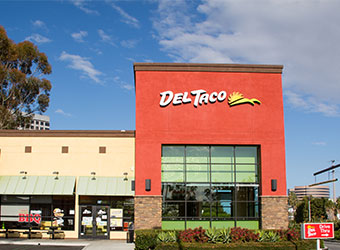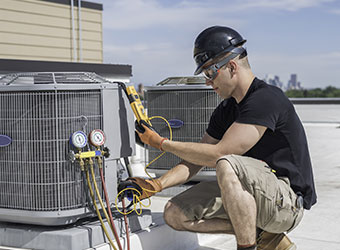Facility and asset management requires keeping track of multiple moving pieces. Whether you’re tracking work orders, vendors, or invoices, you and your team need to create systems that match your business needs.
Developing a network of reliable service providers is a key part of keeping your operations running smoothly. While service providers may not work for your business as employees, successful partnerships minimize interruptions to your equipment and facilities with timely repairs and proactive maintenance.
A reliable, high-quality service provider network is essential for your business, and yet, devoting the time to research and vet service providers can feel like a daunting task.
You’re not alone in your search for the right service provider for your business. Here, we’ll go over how you can approach the task, what you should be looking for in a service provider, and the places and tools you can use to make the process easier.
What to Look for in Your Service Provider
If you were looking to find a new food vendor for your facility, you would take your time in the research phase before signing a contract. You’d ask questions about their sourcing, standards, systems, and other details like payment terms.
The same care and concern should go for your service provider. You’re not just looking for any service provider; you’re looking for a partner who can deliver for your business and your needs. As you start your search, it’s important to keep certain qualities in mind.
Experience & Stability
Just as you draw from your experience to determine your facility management strategy, your service provider should also have a secure foundation of industry experience. Don’t be afraid to ask for details of a potential service provider to understand how “mature” their business is.
Consider starting with questions like:
● How long have you been in business?
● How many clients do you have? (Are any of them local or similar to my business?)
● What is your training and experience?
● What is the training and experience of your employees?

Relevant Certifications
Depending on the exact service, a potential service provider may be required (or simply encouraged) to have certain certifications. Consider asking any service provider about their trade background requirements and any relevant professional certifications.
In addition, if you use technology tools such as facility and asset management software, your service provider should already have the ability to use your system or be willing to undergo training to get up to speed.
Responsiveness and Accessibility
Whether you need to plan scheduled maintenance or last-minute repairs, accessibility is an important trait to look for in a service provider. How quickly your service provider can schedule services is a critical factor in how they will work with your business. Take the time to communicate your expectations at the beginning of the relationship, so you can decide whether potential service providers will be available and accountable when you need them the most.
In addition, don’t want to wait until a critical piece of equipment is broken to figure out who to contact in an emergency. Discuss upfront what methods work best for everyone: phone calls, texts, app messages, emails? How does your facility staff prefer to communicate, and how does the service vendor communicate? Agreeing on these details ahead of time can help you manage expectations and keep both parties happy.
Quality of Work
Ultimately, engaging with a service provider is an investment in your facilities. You want a high quality of work that you can trust. Even though you may sometimes need a service provider to respond urgently, you also don’t want to compromise the quality of work. Your service provider should balance accommodating your immediate needs and meeting expectations.
Courteous & Thorough Communication
Throughout your vetting process, your potential service provider’s communication style can indicate a lot about their customer service.
Both you and the service provider should devote time to developing your relationship, even before any contract is signed or work is completed. While a service provider will inevitably have other clients, they should have the capacity to communicate thoroughly with you as a client.
How to Find the Right Service Provider for Your Next Project
There are many ways to help you find the right talent for the job. You may need to use a mix of different methods to find the partners you need, but investing this effort over time can pay dividends for your facilities.

Online Search & Reviews
One of the most common and immediate ways you can explore for a new service provider is through an online search. You can find names of various service providers, contact information, and even reviews about services.
While this method is relatively easy, it comes with its challenges. Searching for something like “plumber near me” can lead to an almost overwhelming amount of information.
Reviews can be a helpful tool in your search, allowing you to learn about experiences other business owners have had with a certain service provider. However, reviews don’t tell the whole picture. Some quality service providers may not actively prioritize reviews, leaving them as an unknown factor. Other times, reviews may range widely, leaving you unsure about the quality of a vendor.
An online search can provide a lot of information, but you may be left with more questions than answers. Ultimately, the results of an online search may not be extremely well-vetted.
Reviewing Service Provider Websites
If you want to go one step further than online search and reviews, examining service provider websites can tell you a lot about their business. Take a close look at their online presence, including any testimonials, helpful resources, or blogs. An active, thoughtful online presence can indicate that they prioritize communication with their clients — a trait that you want in your service partner.

Word of Mouth
Asking your peers about local service providers can be another great strategy. You can hear from businesses that may be facing similar challenges to your facilities. However, if you aren’t connected locally with other business owners or some businesses are hesitant to share their experiences, you may need to look elsewhere.
Service Provider Directory
Using a tool like a service provider directory can be one of the most effective ways to find your next service provider. These directories leverage word of mouth, relying on service providers that work with real facilities. Because the directory is managed, service providers are also typically more vetted than a generalized online search.
For example, Ecotrak maintains a nationwide service provider network for various trades. Available to Ecotrak customers, this resource connects facility management professionals with service providers that work in their region.
Your business can benefit from direct communication with service providers within the software. These service provider professionals are already trained and up to speed with how to use our facility management software system, allowing you to take advantage of streamlined requests that include equipment details, historical asset information, and even photos.
Finally, with a service provider directory, you can rely on quality indicators like the Ecotrak Certified Vendor Badge, granted to trusted vendors who have completed Service Provider Training.
Finding Service Provider Success
Creating a network of reliable, high-quality service providers takes an investment of time and energy. However, with the right approach and tools at hand, you can develop valuable relationships that support healthy business operations.
Request a personalized demo of Ecotrak today to see how the leading Facility and Asset Management Software can help you find, organize, and leverage quality service providers.
Ecotrak’s full-service provider directory will be launching in July of 2022!
INDUSTRY INSIGHT
What's Happening at Ecotrak
As on-premise dining reopens across the country, restaurant operators continue to adapt their safety procedures to protect guests dining indoors. Restaurants are taking indoor air quality more seriously and taking a proactive approach to disease prevention through ensuring cleaner, safer, more efficient ventilation systems by implementing a variety of indoor air quality best practices.
What is Indoor Air Quality (IAQ)?
Indoor air quality is the air quality within and around buildings and structures. IAQ is known to affect the health, comfort, and well-being of building occupants.
To help guests feel comfortable with indoor dining, restaurant operators can follow CDC, EPA and ASHRAE recommendations for maintaining good restaurant ventilation to reduce indoor airborne transmission of COVID-19. A combination of air cleaners, HVAC filters and IAQ best practices are recommended.
To assist you in your reopening strategy, we’ve compiled a checklist of Indoor Air Quality Best Practices:
HVAC and Air Circulation
• Conduct preventive maintenance on HVAC systems to ensure they are fully operational, especially if the restaurant was closed or operating at a lower capacity.
• Run the HVAC system at maximum outside airflow for 2 hours before and after occupied times.
• Open outdoor air dampers beyond minimum settings to reduce or eliminate HVAC air recirculation.
• Increase circulation of outdoor air as much as possible by opening windows and doors. Use caution in highly polluted areas.
• Use fans to increase the effectiveness of open windows. Avoid placing fans that could cause contaminated air to flow directly from one person to another. Window fans help draw in fresh air without generating strong room air currents.
• Disable demand-controlled ventilation (DCV) controls that reduce air supply based on occupancy or temperature during occupied hours.
• Don’t let HVAC air intakes or open windows pull exhaust air back into the building.
• Set the fan to the “on” position instead of “auto.”
• Keep relative humidity between 40% to 60%.
• Between occupancies, flush the space with three times the amount of fresh air.
Air Filters
• Wear N95 respirators, eye protection (safety glasses, goggles or face shields), and disposable gloves when changing filters.
• Upgrade air filters to MERV-13 or higher.
• Check filters to ensure they are within service life.
• Inspect filter housing and racks to ensure appropriate filter fit and check for ways to minimize filter bypass.
• Use the bag in/bag out air filter replacement method when replacing air filters to mitigate exposure.
Exhaust Fans
• Ensure restroom exhaust fans are working at maximum capacity and are set to stay on.
• Inspect and maintain local exhaust ventilation in areas cooking areas. Operate these systems when these spaces are occupied. Consider operating these systems even when the space is not occupied to increase overall ventilation.
• Generate clean-to-less-clean air movement by re-evaluating the positioning of supply and exhaust air diffusers and/or dampers (especially in higher-risk areas).
Restroom Air
• Keep restroom doors closed, even when not in use.
• Vent separately where possible.
• Keep bathroom windows closed if open windows could lead to re-entrainment of air into other parts of the building.
Products to Consider
• UV-C products
- LEDs
- In-duct air disinfection systems
- Portable room decontamination systems
- Ultraviolet germicidal irradiation (UVGI) systems
- Upper-room UVGI systems provide air cleaning within occupied spaces
- In-duct UVGI systems provide air cleaning inside central ventilation systems
• Bi-polar ionization air purifiers such as Nu-Calgon’s iWave technology
• Portable HEPA fan/filtration systems to help enhance air cleaning
When in doubt, decrease occupancy in areas where outdoor ventilation cannot be increased. Interested in improving Indoor Quality for your business? Contact Erich Munzner at emunzner@ecotech-hvacr.com.
Erich Munzner is the VP of Business Development at Ecotech Refrigeration & HVAC.
Source:
The American Society of Heating, Refrigerating and Air-Conditioning Engineers
National Restaurant Association, COVID-19 Operating Guidance







